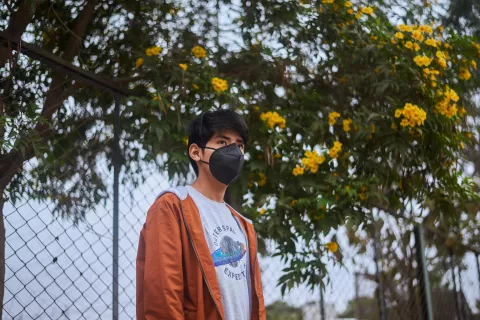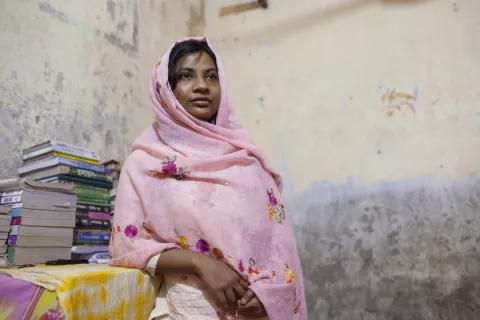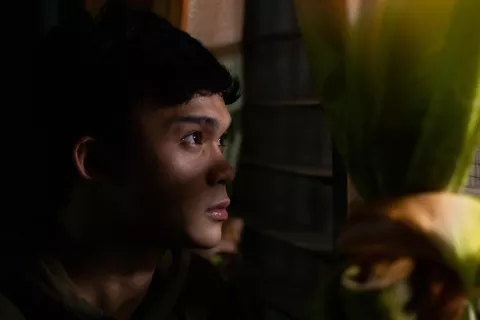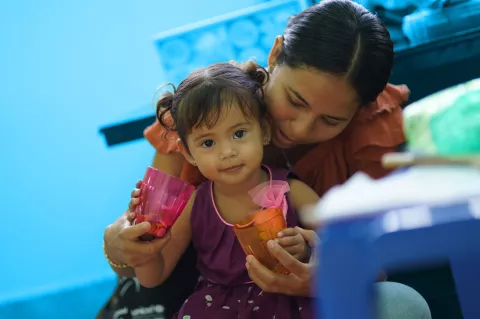Reaching New Heights: A proactive approach to preventing suicide
Kazakhstan is on a path to making mental health – especially for children and young people – a primary national concern.

If you feel your teen is a danger to themselves or others, you can seek help by calling your national helpline. If your country does not have a helpline, please seek professional support from trained and experienced carers.
At home, Dina* has plenty of interests. The 14-year-old plants trees, cares for the garden and dances to K-pop videos in the living room.
At school, things are more difficult, and interacting with peers, stressful.
“They are not like me,” Dina said. “We do not share the same interests.”
Recently, however, Dina has addressed her feelings of stress and anxiety with the help of Bakhytkul Seitkhanova, an educational psychologist.
“[Seitkhanova] taught me to express my thoughts openly,” Dina said. “I feel now that I should never give up.”
Dina was paired with Seitkhanova in 2020 after an assessment conducted as part of the Adolescent Mental Health Promotion and Suicide Prevention Programme (AMHSP), a pivotal school- and health-care-based adolescent mental health awareness and suicide prevention programme in Kazakhstan.
"She was too private,” said Seitkhanova, who works at Dina’s school. “She had problems in her family. I worked with her once a week for two months. I now continue to work with her twice a month.”
AMHSP was founded in 2015 in response to a grave public health concern in Kazakhstan: suicide among young people. Since then, the programme has delivered significant results.
An evaluation of AMHSP from 2015 to 2017 in Kyzylorda, where Dina lives and attends school, showed a 36.1 per cent decrease in suicidal ideation among young people, 80.6 per cent decrease in anxiety, 56.1 per cent decrease in depression and 65 per cent decrease in stress.
In addition to providing critical help to students, AMHSP has also raised awareness about the importance of mental health for school personnel. For Zhaniya Bissenova, an educational psychologist with 15 years of experience, AMHSP changed how she views her work at the 204 School in Kazaly, a town in the Kyzylorda region.
"I realized that children who need help send signals,” Bissenova said.
“I feel more confident as a professional,” she added. “I am not afraid; I act more firmly.”
AMHSP was developed with partners, including UNICEF, as an intervention for school and public health professionals. The goal of the programme is to identify adolescents at risk of mental health conditions such as suicide and provide them with psychosocial support.
In addition, AMHSP also focused on reducing stigma associated with mental health – stigma that can keep young people from seeking help. One of the primary ways the programme addressed stigma was to reach out to parents.
In the region of Kyzylorda, for example, adolescents were only allowed to participate in mental health screenings with parental or caregiver consent. Therefore, AMHSP also focused on helping school and health-care workers reach parents with information. As a result of the programme, the number of parents who refused to give permission for mental health screenings dropped to 5 per cent from 2015 to 2016 and to 1 per cent by 2017. In a sign of strong support from the highest levels of government, the Kazakhstan Prime Minister featured AMHSP in the country’s National Action Plan for 2015–2020, and in 2015, implementation of AMHSP began in the Kyzylorda region with support from partners, including: the country’s National Centre for Mental Health; the ministries of health, education and science, and internal affairs (police); and the regional health and education departments. In 2016, implementation began in the Mangistau region.
Overall, Kazakhstan is on a path to making mental health – especially for children and young people – a primary national concern. The Government of Kazakhstan is embracing AMHSP as a centrepiece of adolescent mental health services and has increased financing for mental health services by 25 per cent.
However, the success of these efforts will ultimately be measured by improvements in the lives of children and young people.
Dina, for one, is on her way.
“No matter the difficulties, you need to go forward,” Dina said. “And by overcoming difficulties, you will reach heights.”
* Dina is a pseudonym being used at her request to protect her identity. She was interviewed in May, 2021 while walking through mulberry trees on a main street in Kyzylorda, Kazakhstan. This and other stories like hers feature in the State of the World’s Children report 2021 - On My Mind: Promoting, protecting and caring for children’s mental health.




